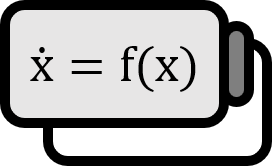Lyapunov Function
Definition1
Given a space $X$ and a function $f : X \to X$, suppose the following vector field is given by a differential equation. $$ \dot{x} = f(x) $$ For a point $x_{0} \in X$ in the above autonomous system, a scalar function $V \in C^{1} \left( \mathcal{N} (x_{0}) , \mathbb{R} \right)$ defined in the neighborhood $\mathcal{N} \left( x_{0} \right)$ of $x_{0}$ is called a Liapunov function if it satisfies the following conditions:
- (i): $V(x_{0}) = 0$, and for $x \ne x_{0}$, then $V(x) > 0$
- (ii): At $x \in \mathcal{N} \left( x_{0} \right) \setminus \left\{ x_{0} \right\}$, $V ' (x) \le 0$
- $C^{1}(A,B)$ denotes the set of functions whose domain is $A$ and codomain is $B$, which are differentiable and have continuous derivatives.
- $V$ belonging to $C^{1} \left( \mathcal{N} (x_{0}) , \mathbb{R} \right)$ means that $V$ is a scalar function defined in the neighborhood of $x_{0}$, differentiable, and $v '$ is continuous.
Explanation
A Liapunov function may exist depending on the given system $\dot{x} = f(x)$, and it can be considered especially to check the stability of a fixed point $x_{0} = \overline{x}$ when $X = \mathbb{R}^{n}$. The existence of a Liapunov function implies stability, and $V$ should be appropriately defined according to the system $f$. $v '$ literally refers to the derivative with respect to time $t$, and when differentiating $V$, terms related to $\dot{x}$ emerge, revealing the relationship with $f$.
From the above explanation, it may seem that a Liapunov function is a universal tool for understanding nonlinear systems, but as nonlinear systems are inherently difficult, finding this Liapunov function is not simple. There is no general method to find a Liapunov function, and in fact, finding it even for a single important system can be a challenging research topic.
Example
Let’s take a look at a very simple example of finding a Liapunov function: $$ \begin{align*} \dot{x} =& -x + 4y \\ \dot{y} =& -x - y^{3} \end{align*} $$ This system has a fixed point $(0,0)$. As mentioned, there is no general method for finding a Liapunov function, so intuition must be employed. As one gets used to finding Liapunov functions, the process becomes faster. Here, we assume that $V(x,y) = x^{2} + a y^{2}$ is a Liapunov function and will find it by specifying the value of $a \ge 0$.
Part 1.
Given $V(0,0) = 0$, and for $(x,y) \ne (0,0)$, $V(x,y) > 0$ holds. From $(0,0)$, $V = 0$, and assuming $a$ is non-negative, $V > 0$.
Part 2.
From $(x,y) \in \mathcal{N} \left( (0,0) \right) \setminus \left\{ (0,0) \right\}$, $V ' (x,y) \le 0$. Differentiating $V$ with respect to $t$ gives: $$ \begin{align*} {{ d V } \over { d t }} =& 2 x \dot{x} + 2 a y\dot{y} \\ =& 2x(-x+4y) + 2ay \left( -x-y^{3} \right) \\ =& -2x^{2} + (8-2a)xy - 2ay^{2} \end{align*} $$ If $a=4$, then $V ' <0$.
Thus, given the fixed point $(0,0)$, we can guarantee the existence of a Liapunov function as $V(x,y) = x^{2} + 4 y^{2}$, and it follows that $(0,0)$ possesses Liapunov stability based on its existence.
Strogatz. (2015). Nonlinear Dynamics And Chaos: With Applications To Physics, Biology, Chemistry, And Engineering (2nd Edition): p201. ↩︎
